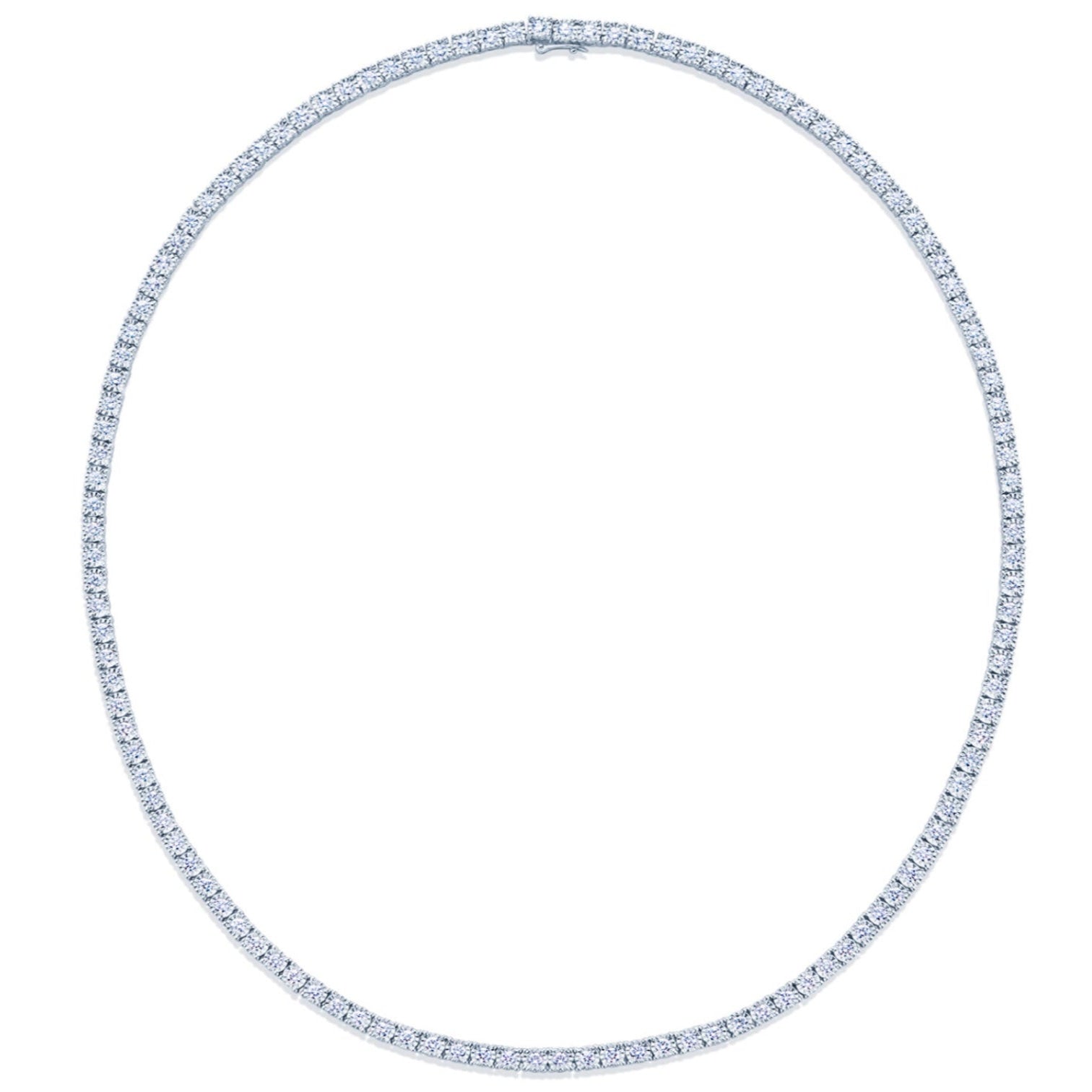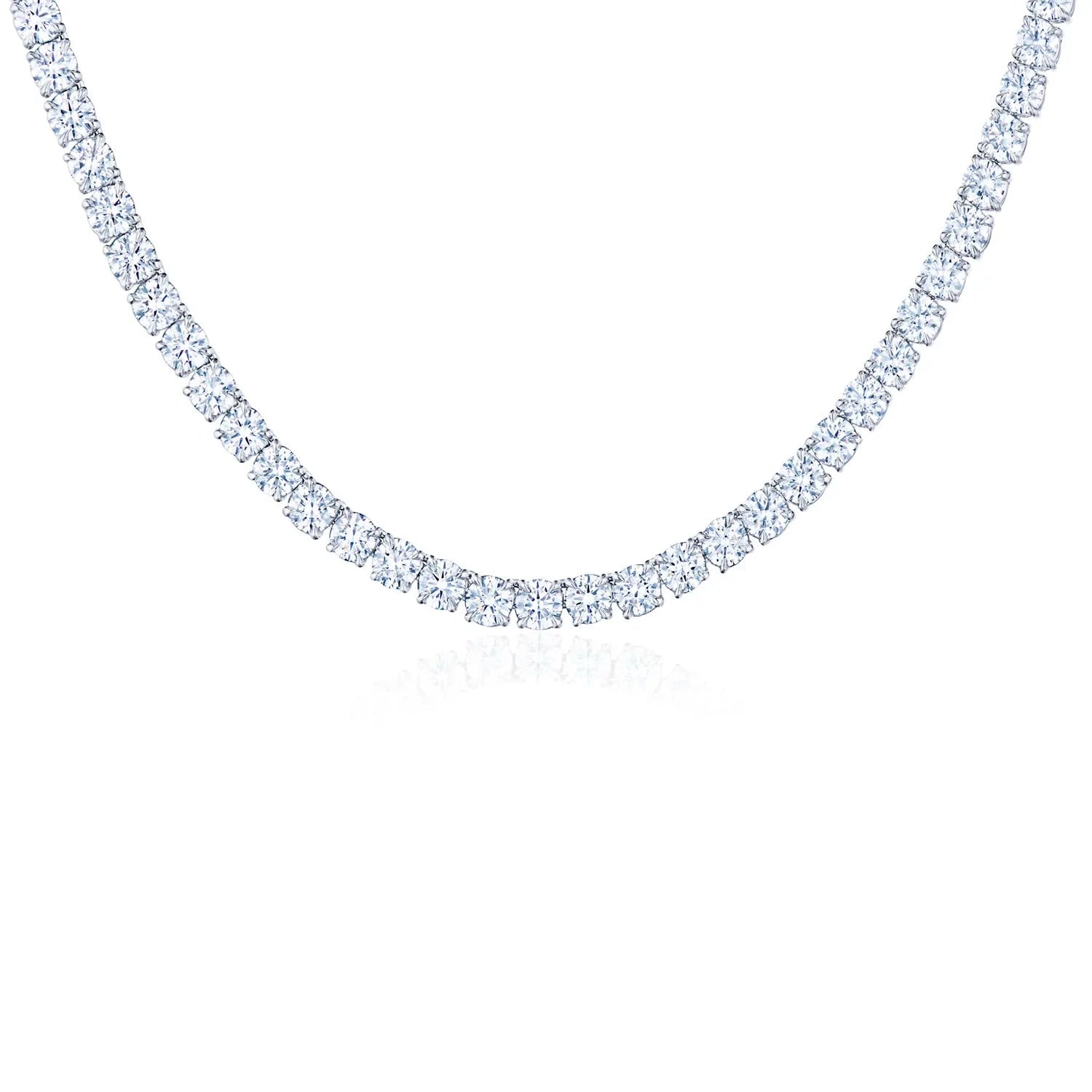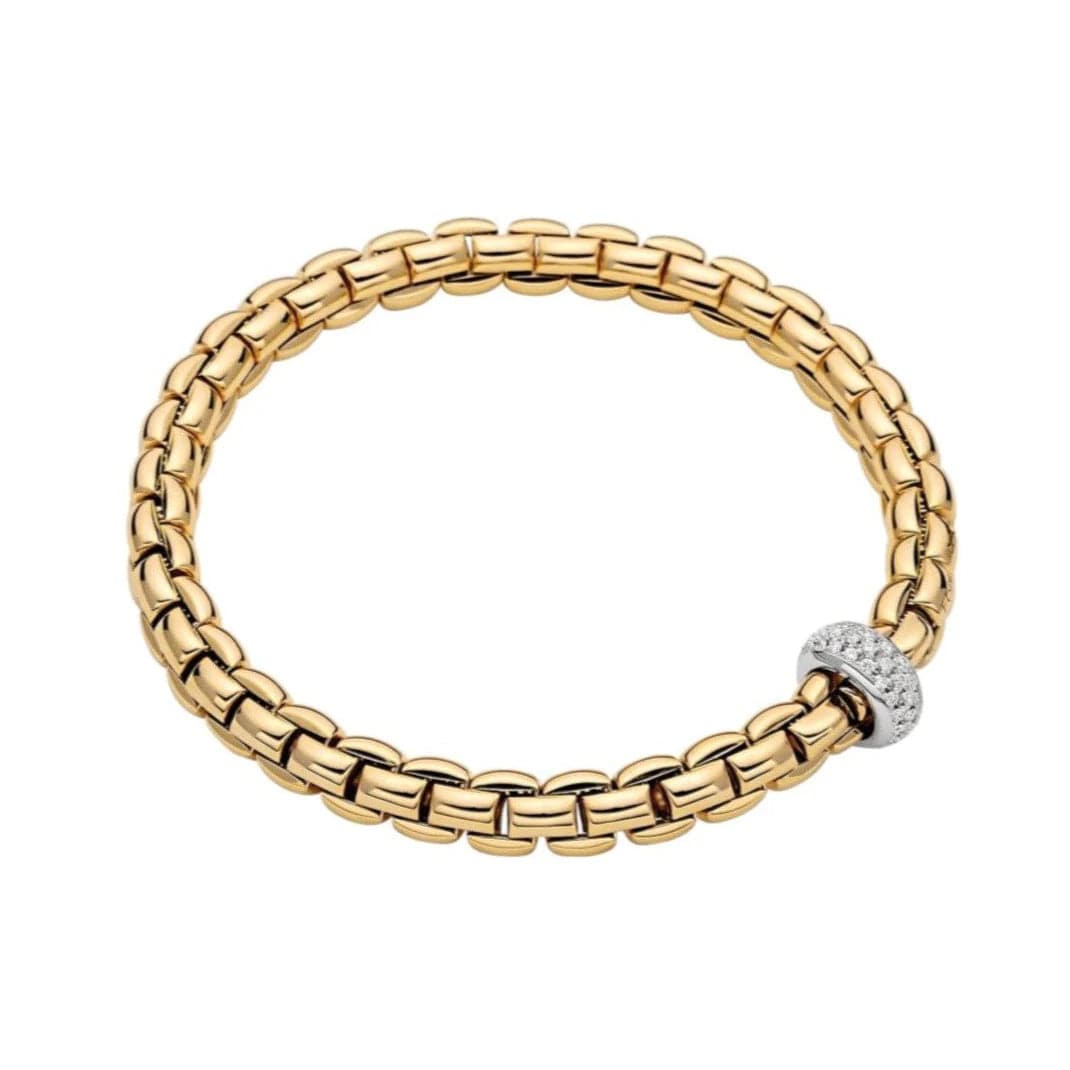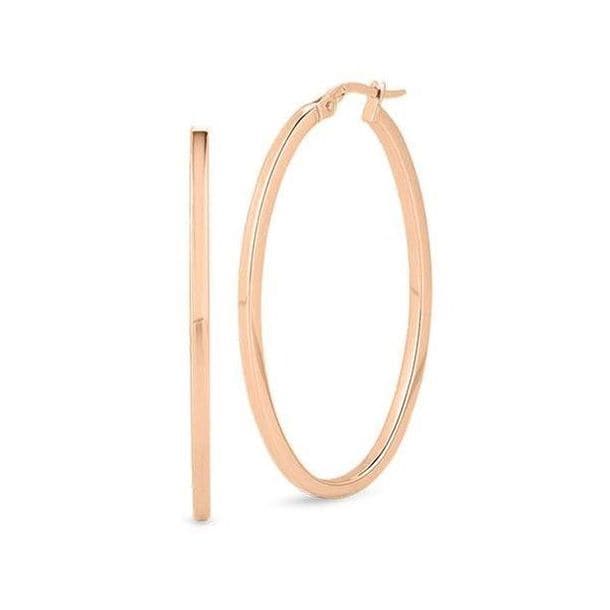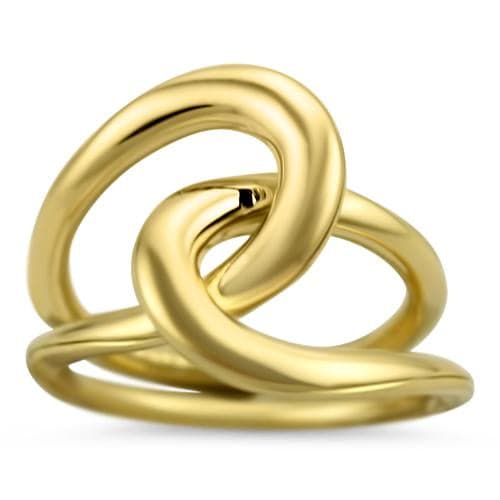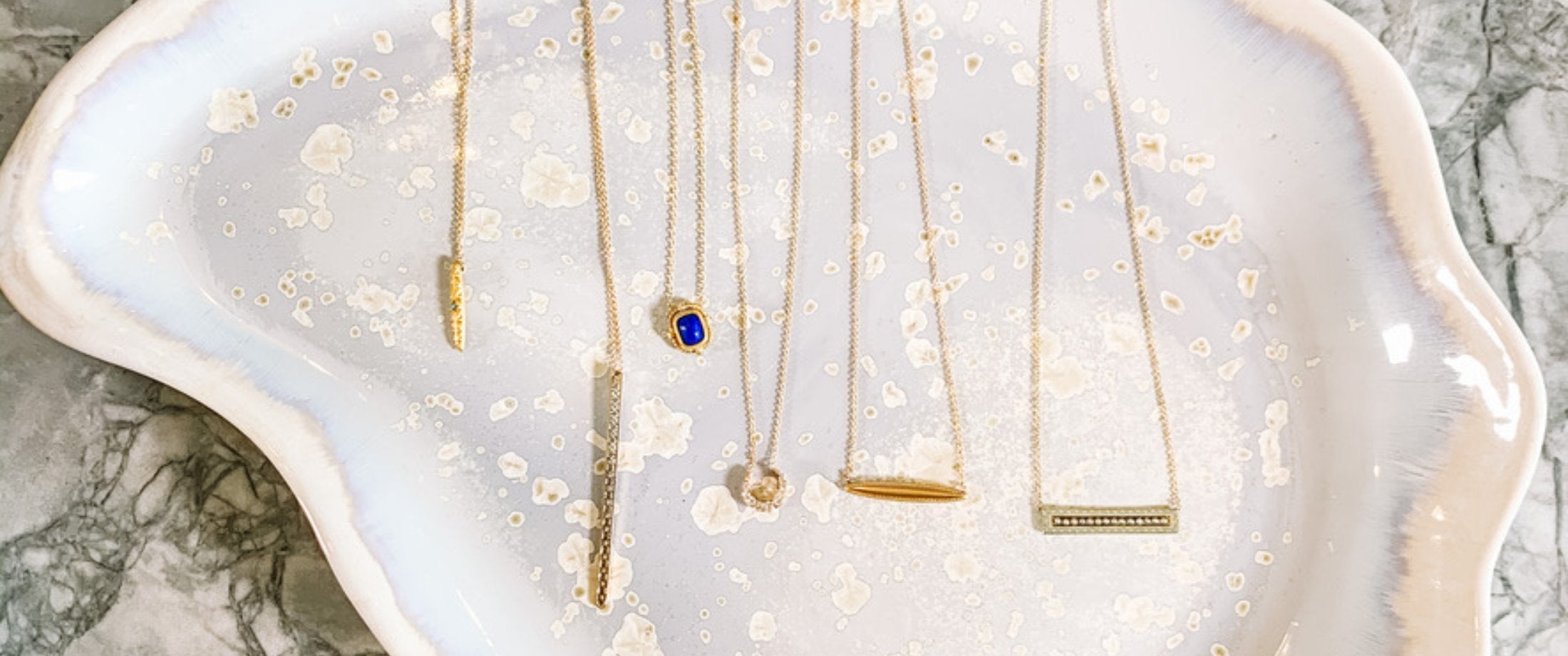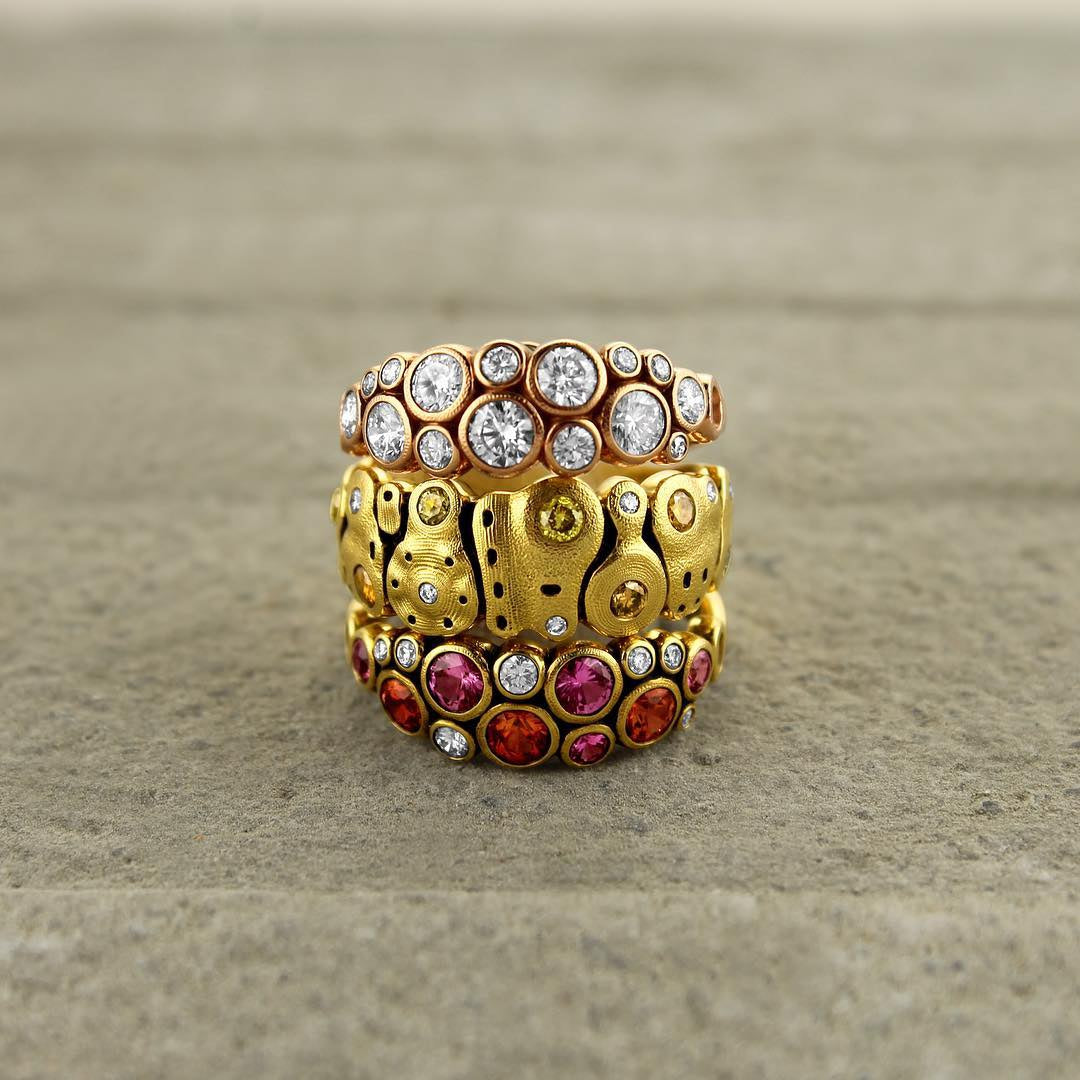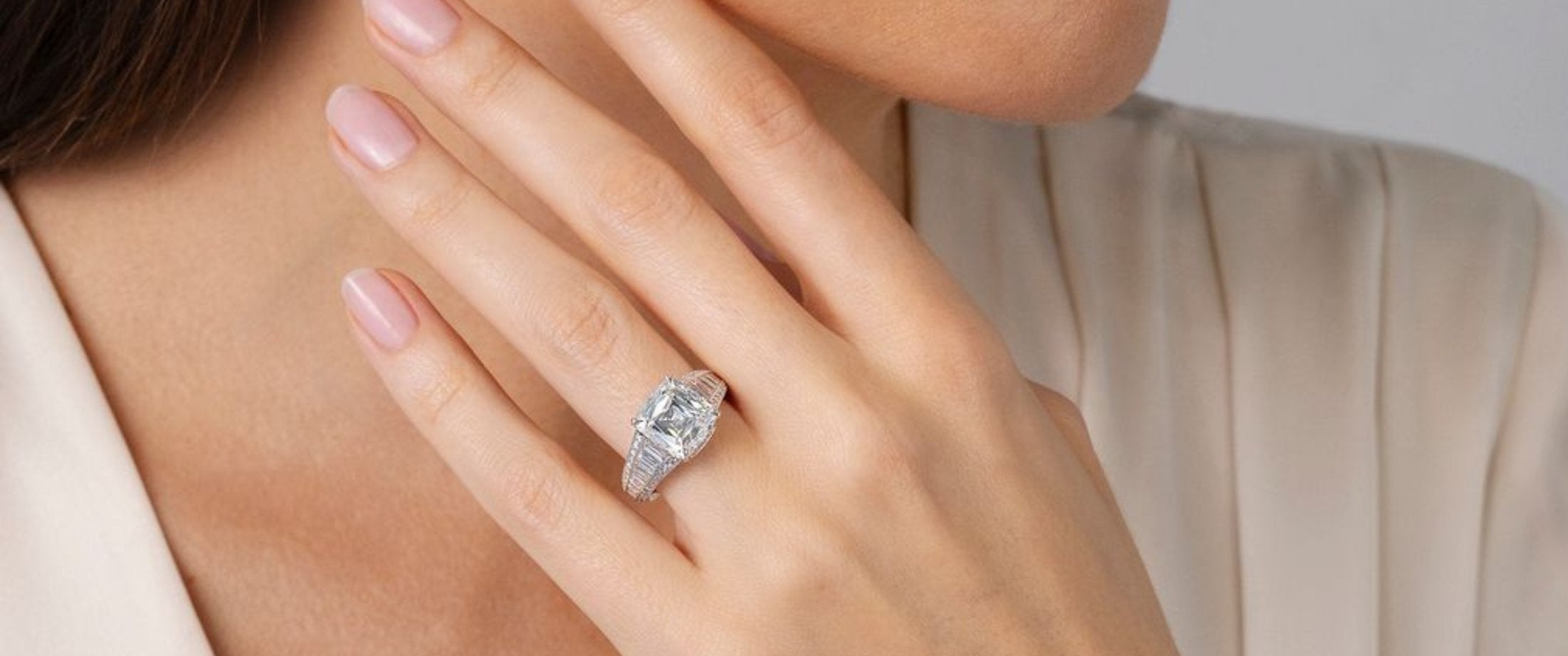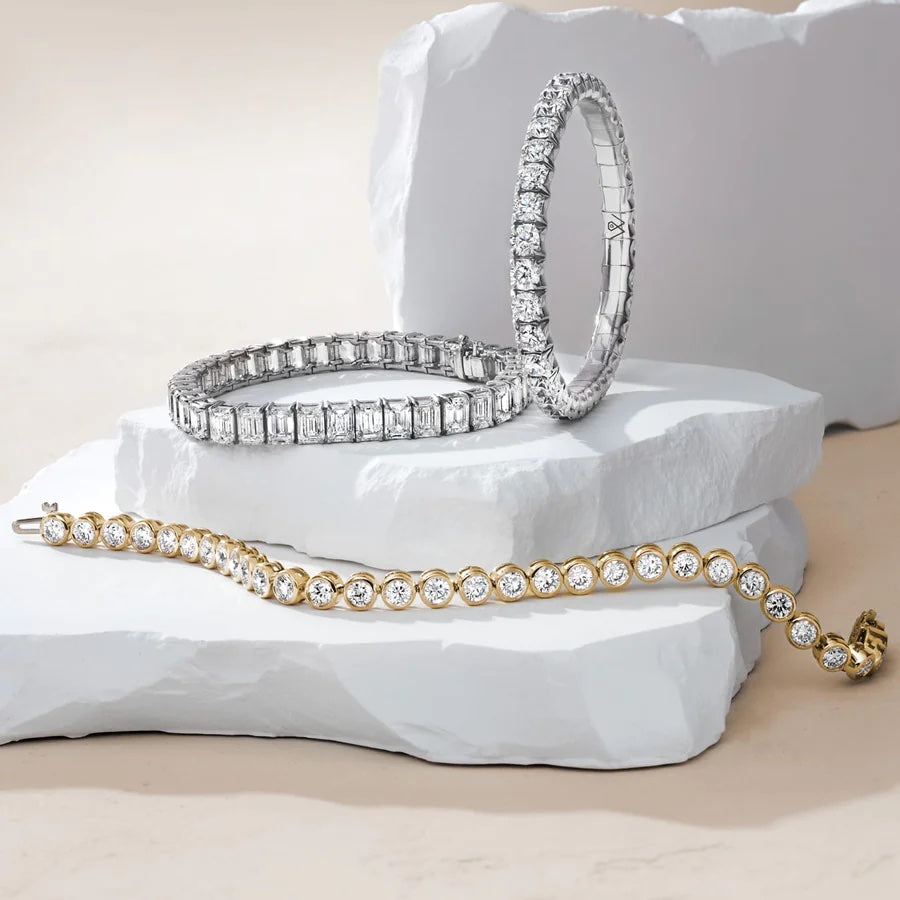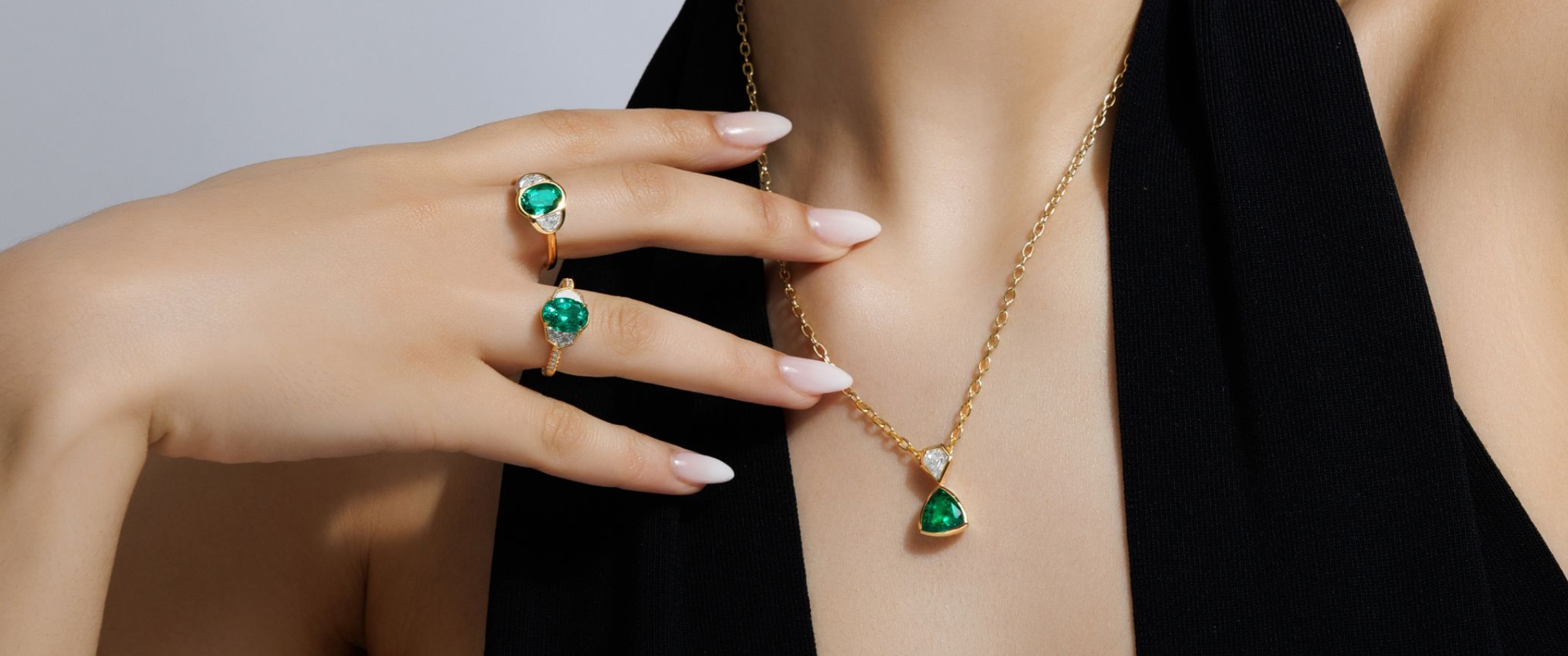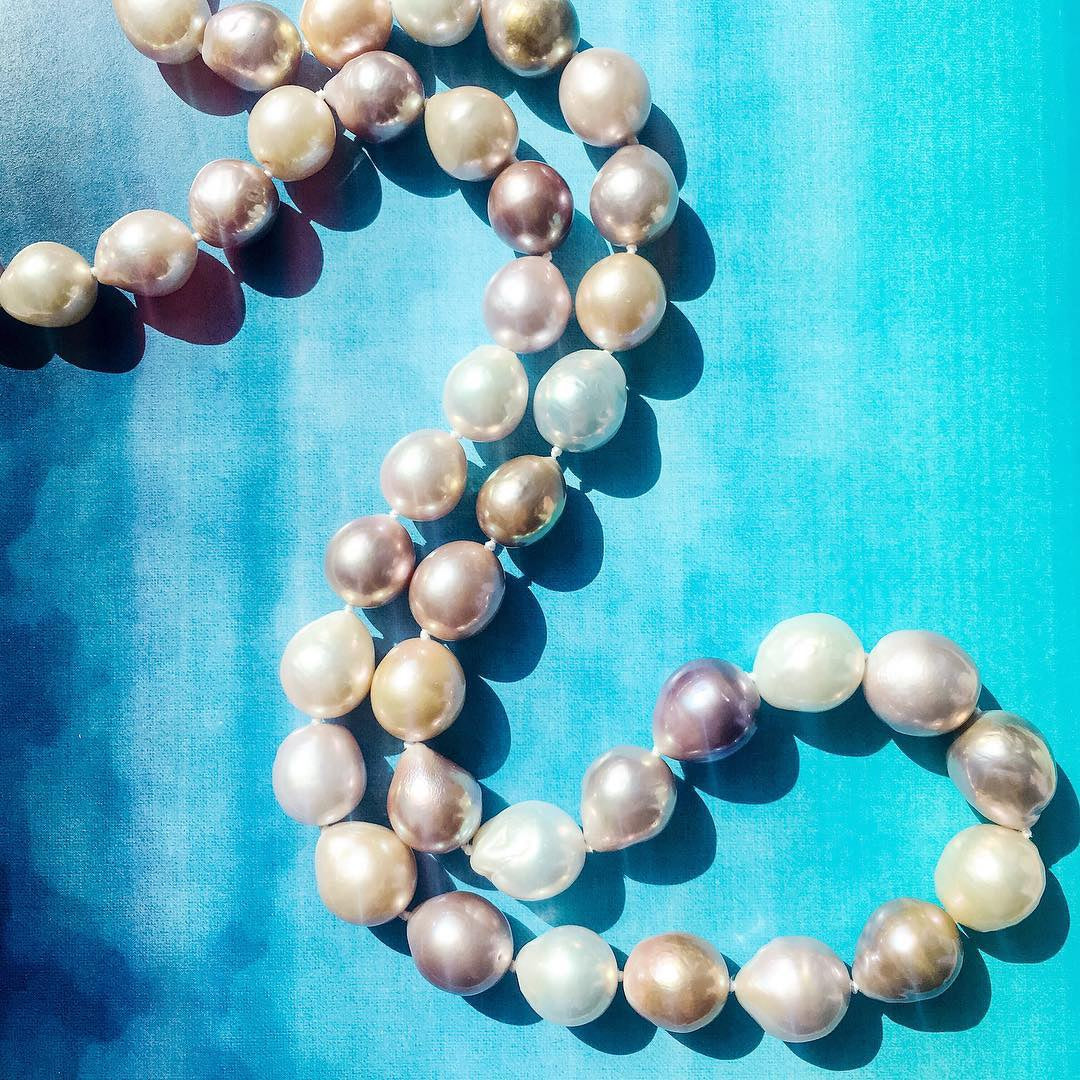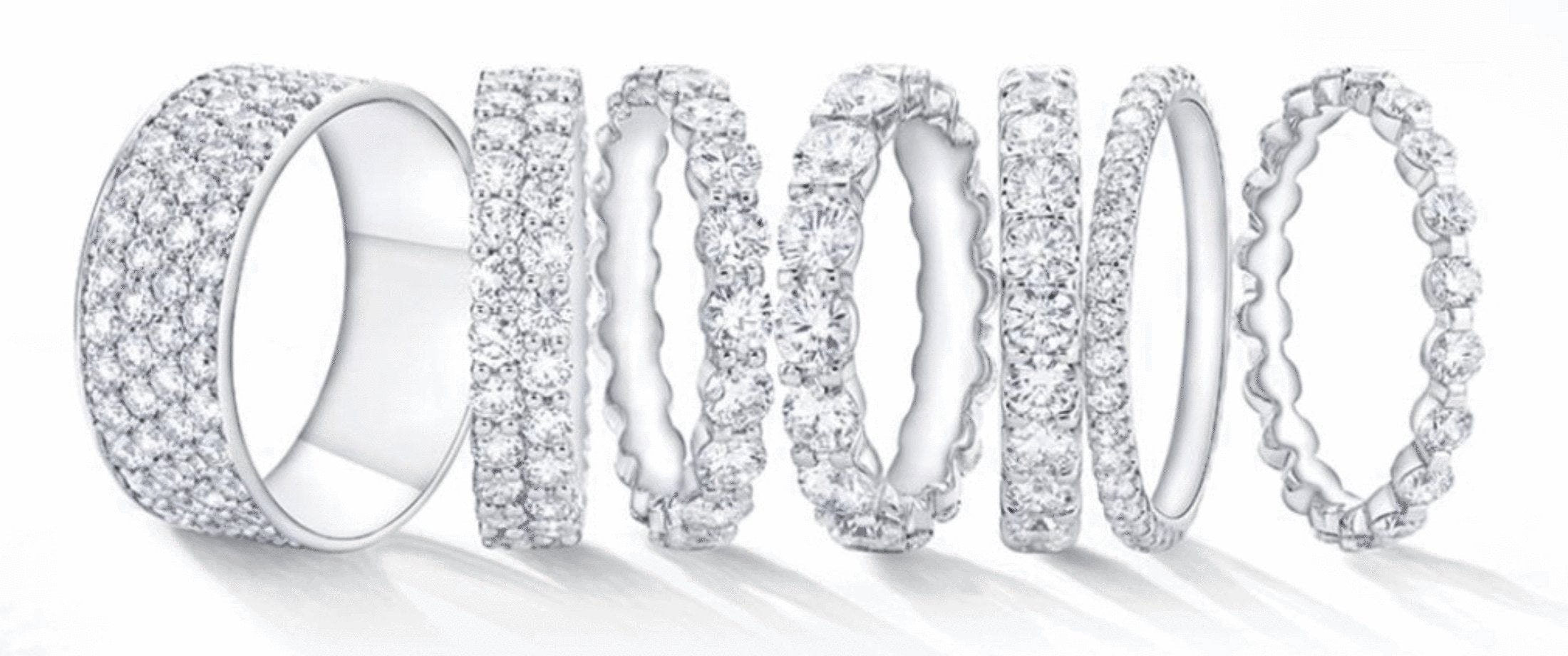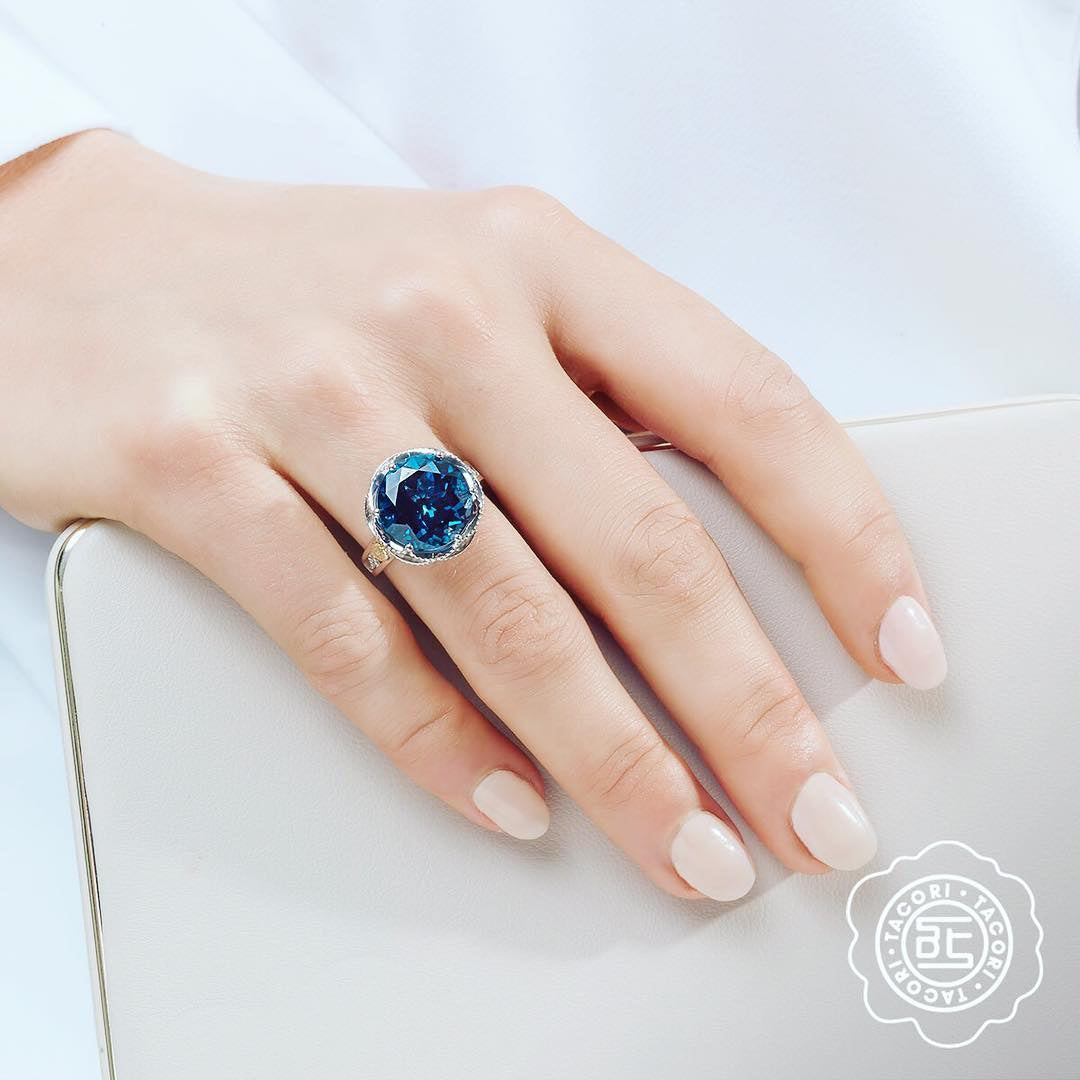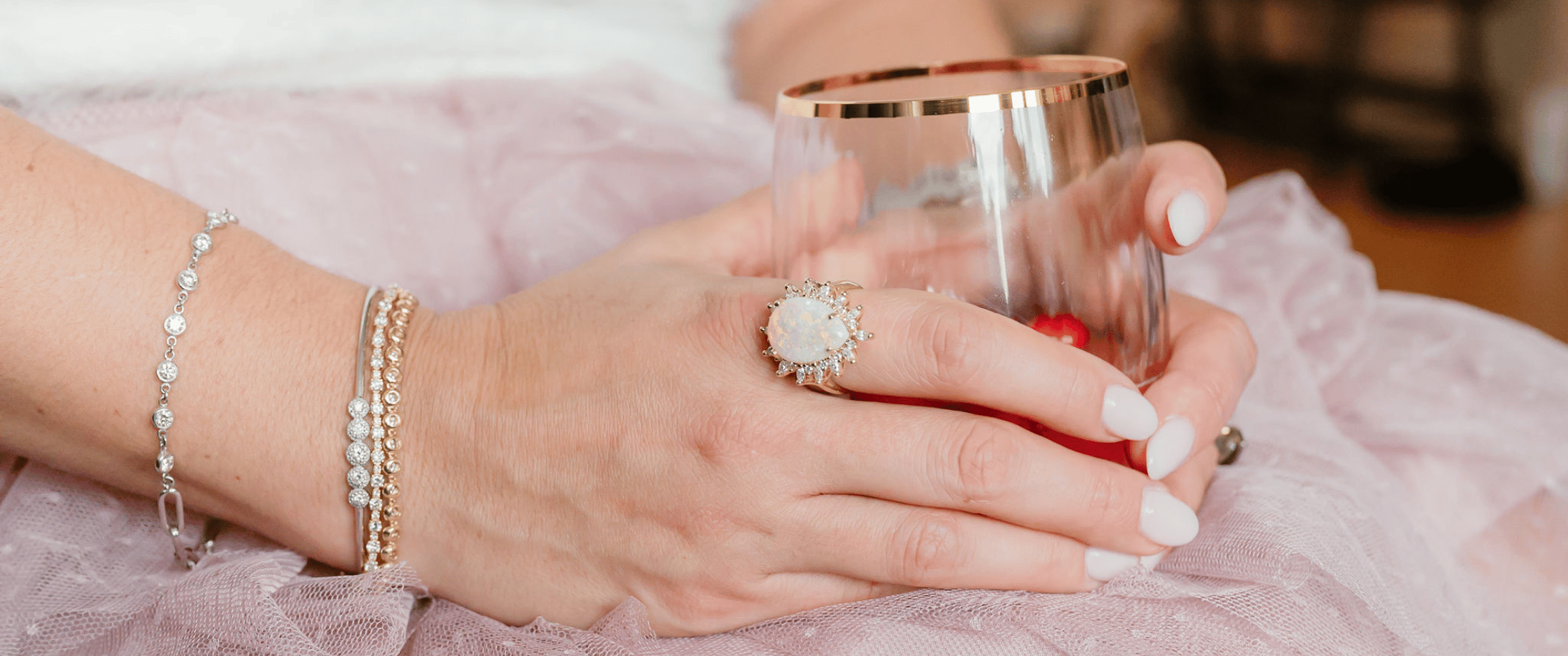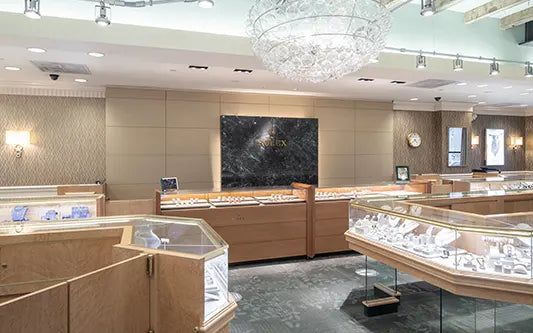
The Ultimate Gemstone Guide
Discover the amazing stories behind some of the most popular gemstones and learn how to care for your gemstone and diamond jewelry to keep them looking like the day you bought them.
Alexandrite - June Birthstone
Background: First discovered in 1830, and named for the young Czar Alexander II. It caught the country's attention because its red and green colors mirrored the Imperial Russian flag. Often described by gem aficionados as “emerald by day, ruby by night."
Why we love alexandrites: Green in sunlight. Red in lamplight. Color-changing alexandrite is nature’s magic trick.
Care: Can be cleaned in warm, soapy water. Ultrasonic cleaning is usually safe.
Shop our collection of Alexandrite Jewelry >>
Amethyst - February Birthstone, 6th Anniversary
Background: Used as a gemstone by the ancient Egyptians, ancient tales say Cleopatra wore an amethyst signet ring as did St. Valentine, his engraved with the figure of Cupid. The Greeks believed amethyst gems could prevent intoxication, while medieval European soldiers wore amethyst amulets as protection in battle in the belief that amethysts heal people and keep them cool-headed. Amethyst was as expensive as ruby and emerald until the 19th Century, when Brazil’s large deposits were discovered. Today, as the most valued quartz variety, amethyst is in demand for designer pieces and mass-market jewelry alike, and its purple to pastel hues retain wide consumer appeal.
Why we love amethysts: The essence of the color purple, amethyst is beautiful enough for crown jewels yet affordable enough for class rings.
Care: Ultrasonic cleaning is usually safe. Avoid steam cleaning, abrupt temperature changes, heat, intense sunlight, and strong chemicals.
Shop our collection of Amethyst Jewelry >>
Aquamarine - March Birthstone, 19th Anniversary
Background: The name Aquamarine comes from the Latin aqua marinus, meaning "water of the sea," and refers to its sparkling ocean-like color. Ancient Greeks believed the Sirens, mythical temptresses of seafarers, emptied aquamarines from their treasure caskets into the seas. A sailor home from a voyage often presented his love an aquamarine to celebrate their mutual fidelity and long awaited reunion. Ever since, March’s birthstone is believed to enhance the happiness of marriages.
Why we love aquamarines: Named after seawater, aquamarine’s fresh watery hue is a cool plunge into a refreshing pool.
Care: Ultrasonic or steam cleaning is usually safe if inclusion free. Avoid hydrofluoric acid. Generally heat resistant if inclusion free.
Shop our collection of Aquamarine Jewelry >>
Citrine - November Birthstone
Background: People have used quartz in jewelry for thousands of years. In ancient times, citrine was worn as a protection against snake venom and evil thoughts. Derived from the Latin word citrina which means "yellow", Citrine has been referred to as the "merchant's stone" or "money stone", due to a superstition that it would bring prosperity.
Why we love citrines: Its attractive color, plus the durability and affordability, makes it the top-selling yellow-to-orange gem.
Care: Ultrasonic cleaning is usually safe. Avoid steam cleaning, abrupt temperature changes, heat, intense sunlight, and strong chemicals.
Shop our collection of Citrine Jewelry >>
Diamond - April Birthstone, 10th & 60th Anniversary
Background: One of the best-known and most sought-after gemstones, diamonds have been used as decorative items since ancient times; some of the earliest references can be traced back to 25,000 - 30,000 B.C. Ancient Hindus believed that diamonds resulted when thunderbolts hit the earth and before diamonds were discovered in Brazil in the 1700s, India was the only place where diamonds were mined. Diamonds used in engagement rings is a practice documented among European aristocracy as early as the 15th century, though ruby and sapphire were more desirable gemstones at the time. Mary of Burgundy is the first known recipient of a diamond engagement ring, in 1477.
Why we love diamonds: Diamonds are among nature’s most precious and beautiful creations.
Care: Using a mix of mild soap (we recommend Simple Green) and warm water, gently dip your jewelry into the cleaning solution and use only a soft brush. Thoroughly rinse in lukewarm water. Ultrasonic or steam cleaning is usually safe if inclusion free. We also have complimentary jewelry cleaner available in all of our stores.
Shop our collection of Diamond Jewelry >>
Emerald - May Birthstone, 20th & 25th Anniversary
Background: Emerald’s lush green has soothed souls and excited imaginations since antiquity. Throughout time, emerald has been an eternal symbol of one's desire for youth, vitality, and rebirth. The name is derived from ancient Greek smaragdus for green. Emerald is the traditional gemstone for the astrological signs of Cancer.
Why we love emeralds: Emeralds have been cherished by Spanish conquistadors, Inca kings, Moguls, and pharaohs, with the oldest emerald dating back 2.97 billion years from South Africa.
Care: Clean gently with warm, soapy water; avoid heat, solvents, and hydrofluoric acid.
Shop our collection of Emerald Jewelry >>
Garnet - January Birthstone, 2nd Anniversary
Background: Garnet's name originates from the Greek granatum, meaning seed-like, as in the color of pomegranate seeds. Thousands of years ago, red garnet necklaces adorned the necks of Egypt’s pharaohs, and were entombed with their mummified corpses as prized possessions for the afterlife. In ancient Rome, signet rings with carved garnets were used to stamp the wax that secured important documents.
Why we love garnets: Garnets come in a rich palette of rainbow colors: greens, oranges, pinkish oranges, deeply saturated purplish reds, and even some blues.
Care: Ultrasonic cleaning is safe, never steam clean. Avoid abrupt temperature changes and hydrofluoric acid.
Shop our collection of Garnet Jewelry >>
Mother-Of-Pearl
Background: Intricate inlays of mother-of-pearl were placed in silver pieces as far back as 2600 B.C. Mother-of-pearl, also called nacre, is a shimmering, iridescent layer of material that forms the shell lining of many mollusks. Pearl oysters and abalone are both sources of mother-of-pearl, which comes in several natural colors.
Why we love Mother-of-pearl: From watch dials to antique jewelry, Mother-of-pearls has been highly regarded since Mesopotamia, when it was used to honor royalty.
Care: Use mild soap and water to clean. Avoid storing with jewelry which may scratch it.
Shop our collection of Mother-of-Pear Jewelry >>
Onyx
Background: The name comes from the Greek word which means nail of a finger or claw. Legend says that one day while Venus was sleeping, Cupid cut her fingernails and left the clippings scattered on the ground. Because no part of a heavenly body can die, the gods turned them into the stone that became known as onyx.
Why we love onyx: While it may be the gemstone's black beauty that it is most known for, we love the green onyx mined out of Brazil that was often used in the Art Deco era of the 1920s and 1930s.
Care: Can chip or crack easily, avoid dropping. Clean with a soft, dry cloth.
Shop our collection of Onyx Jewelry >>
Opal - October Birthstone, 14th Anniversary
Background: The gem with the flash-fire colors of the skies – rainbows, lightning, fireworks – was believed by ancient Arabs to have fallen from the heavens in flashes of lightning. The Orphanus Opal in the Holy Roman Emperor's crown was described as "pure white snow, flashed and sparkled with the color of bright ruddy wine." Napoleon Bonaparte gave the famed "Burning of Troy" opal, with its red flashes, to his Helen, the Empress Josephine.
Why we love opals: Fireworks. Jellyfish. Galaxies. Lightning. Opal’s shifting play of kaleidoscopic colors is unlike any other gem.
Care: Clean only with warm, soapy water; avoid heat, abrupt temperature changes, strong alkalis, and hydrofluoric acid.
Shop our collection of Opal Jewelry >>
Pearl - June Birthstone, 3rd & 30th Anniversary
Background: People have coveted natural pearls as symbols of wealth and status for thousands of years. A Chinese historian recorded the oldest written mention of natural pearls in 2206 BC. As the centuries progressed toward modern times, desire for natural pearls remained strong. Members of royal families as well as wealthy citizens in Asia, Europe, and elsewhere treasured natural pearls and passed them from generation to generation. Pearls—natural and cultured—occur in a wide variety of colors. The most familiar are white and cream, but the palette of colors extends to every hue. Natural pearls form around a microscopic irritant in the bodies of certain mollusks. Cultured pearls are the result of the deliberate insertion of a bead or piece of tissue that the mollusk coats with nacre.
Why we love pearls: Perfect shining spheres. Lustrous baroque forms. Seductive strands, warm to the touch. Pearls are simply and purely organic.
Care: Clean your pearl jewelry by wiping it with a soft cloth when you take it off, as traces of perfume, hair spray, or any acid-based cosmetics can cause damage to the pearl's nacre. If your pearl jewelry pieces show more soil than a soft cloth can remove, wash them carefully in mild soap and lukewarm water, rinse, gently blot with a soft cloth, and allow to air dry.
Shop our collection of Pearl Jewelry >>
Peridot - August Birthstone, 16th Anniversary
Background: Peridot is rooted in the Greek word peridona meaning plentiful. Peridot is primarily mined on a small Egyptian island where nothing grows, there is no fresh water, and the temperature is scorching for the majority of the year. Since antiquity, this Red Sea island, named Zabargad in Arabic, has been a main source for peridot. Some of its geologic fissures are lined with gem crystals, and tiny peridot crystals give some of its beaches a greenish hue. Today this gem is still prized for its restful yellowish green hues and long history.
Why we love peridots: Found in lava, meteorites, and deep in the earth’s mantle, yellow-green peridot is the extreme gem.
Care: Avoid ultrasonic cleaning and never steam clean; avoid heat, acids, and jeweler's pickling solution.
Shop our collection of Peridot Jewelery >>
Quartz
Background: Quartz has attracted attention from the earliest times; water-clear crystals were known to the ancient Greeks as krystallos, hence the name crystal, or more commonly rock crystal, applied to this variety. The name quartz is an old German word of uncertain origin first used by Georgius Agricola in 1530.
Care: Use mild soap and water to clean.
Shop our collection of Quartz Jewelry >>
Ruby - July Birthstone, 15th & 40th Anniversary
Background: Described in ancient texts as "the perpetually glowing fire that never is extinguished," the ruby has represented the pinnacle of precious gemstone color through the ages. 13th century adventurer Marco Polo told of the King of Ceylon's incredible gem, 9 inches in diameter and as thick as a man's arm. It is said that Kublai Khan, Mongol emperor of China, offered an entire city for it. Biblical psalmists used the ruby as the standard to measure virtue, integrity, and wisdom.
Why we love rubies: Ruby is one of the most historically significant colored stones and was one of the most sought-after gems of European royalty. Today, the desire for ruby is just as great as it always has been. As a symbol of passion, ruby makes an ideal romantic gift.
Care: Ultrasonic and steam cleaning are usually safe, but avoid if fissures are present.
Shop our collection of Ruby Jewelry >>
Sapphire - September Birthstone, 5th & 45th Anniversary
Background: The blue gem of the ages, sapphire has roots in the Greek sappheiros for Sappherine, the island where ancient Greek writings say sappheiros were discovered. In ancient Persian lore, the earth is said to have rested on a large sapphire whose reflection colored the skies. In Hebrew tradition, the Ten Commandments were written on sapphire tablets. Through the ages, the gem symbolized purity, wisdom, and prophecy.
Why we love sapphires: While most jewelry customers think all sapphires are blue, sapphires also come in violet, green, yellow, orange, pink, purple, gray, black, and brown. (Just not red - those gemstones are called rubies!)
Care: Ultrasonic and steam cleaning are usually safe, but avoid if fissures are present.
Shop our collection of Sapphire Jewelry >>
Tanzanite
Background: Named by Tiffany & Co. after the East African state of Tanzania where it was mined, Tanzanite was enthusiastically celebrated by gemologists as the 'gemstone of the 20th century' upon its discovery in 1967.
Why we love tanzanite: Poised between lush blue, vibrant violet, and rich purple, exotic tanzanite is found in only one place on earth, near majestic Mount Kilimanjaro.
Care: Tanzanite is relatively soft, and requires careful and respectful handling to avoid damage. Polish occasionally with a soft, dry cloth. Avoid heat cleaners and sonic cleaners, both of which can damage the tanzanite. Can be cleaned in warm, soapy water. Dry carefully before storing.
Shop our collection of Tanzanite Jewelry >>
Topaz - December Birthstone, 4th Anniversary
Background: "Topaz" is derived from the Sanskrit word tapas, meaning fire. Topaz aptly symbolized the sun gods of ancient cultures and was credited with many healing powers, among them the ability to cure insanity, asthma, weak vision, and insomnia.
Why we love topaz: Honey yellow. Fiery orange. Cyclamen pink. Icy blue. In warm or cool tones, topaz is a lustrous and brilliant gem.
Care: Usually safe to ultrasonic clean; avoid steam cleaning, rapid temperature changes, acids, and strong solvents.
Shop our collection of Topaz Jewelry >>
Tourmaline - November Birthstone
Background: Tourmaline is a gem with an incomparable variety of colors. The reason, according to an old Egyptian legend, is that on its long journey up from the center of the Earth, Tourmaline passed over a rainbow. In doing so, it assumed all the colors of the rainbow. That is why it is still referred to as the "gemstone of the rainbow." Colored crystals were imported from Sri Lanka at the beginning of the 18th century. During medieval times tourmaline was thought to heal physical and mental disorders as well as prevent death.
Why we love tourmaline: In addition to being mined in our great state of Maine, tourmaline has one of the widest color ranges of any gems.
Care: Protect from scratches and sharp blows. Avoid drastic temperature changes. Do not clean in a home ultrasonic cleaner.
Shop our collection of Tourmaline Jewelry >>
Turquoise - December Birthstone, 11th Anniversary
Background: Turquoise is one of the earliest known gems, used in jewelry, utensils, and religious ritual items. The mummy of ancient Egyptian Queen Zer, dating from 5500 B.C., was discovered with her arm encased by four exquisite turquoise bracelets. The name turquoise is believed to originate from the French phrase pierre turquoise, or Turkish stone, because of its importation to Europe by Venetian merchants who first purchased it in Turkish bazaars.
Why we love turquoise: Azure sky, robin’s egg blue: vivid shades of turquoise define the color that’s named after this gem.
Care: Clean only in warm, soapy water and dry immediately; avoid skin oils, perspiration, acids, and strong solvents.
Shop our collection of Turquoise Jewelry >>
At Springer's, we take pride in presenting you with renowned designer brands that are synonymous with excellence. From the iconic designs of Roberto Coin and Hearts On Fire, to the unique creations of Alex Sepkus, our selection ensures you access the very best of the jewelry world. Immerse yourself in a world where each piece narrates a story of unparalleled craftsmanship and superior quality.
Shop our unparalleled selection of diamond, platinum, gold, sterling silver, and pearl jewelry including earrings, bracelets, necklaces, pendants, and rings.
Whether you prefer the classic allure of timeless pieces or the contemporary charm of modern designs, our designer collections has something for every discerning taste.




